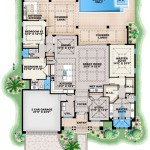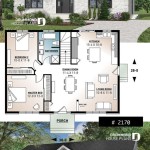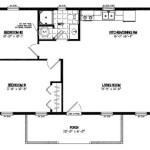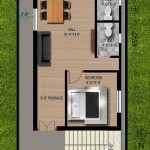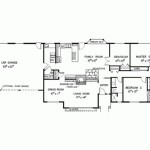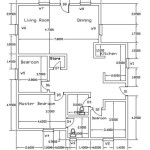Small House Plans With Loft Master Bedroom And Kitchen
The concept of small house living has gained significant traction in recent years as individuals and families seek more sustainable, affordable, and manageable lifestyles. Small house plans, particularly those incorporating a loft master bedroom and integrated kitchen designs, offer a compelling solution for maximizing space and functionality within a compact footprint. These designs prioritize efficient use of vertical space, creating distinct living zones while maintaining an open and connected atmosphere. The following explores the key considerations, benefits, and design principles involved in creating successful small house plans with a loft master bedroom and kitchen.
One of the primary advantages of a small house is reduced environmental impact. Smaller homes consume less energy for heating, cooling, and lighting, leading to lower utility bills and a smaller carbon footprint. The use of sustainable building materials and energy-efficient appliances further enhances the ecological benefits. Beyond environmental considerations, small homes often require less maintenance and upkeep, freeing up valuable time and resources for other pursuits. The financial benefits are also substantial, with lower mortgage payments, property taxes, and insurance costs. This allows homeowners to allocate their finances more strategically, supporting other goals such as travel, education, or investment.
The incorporation of a loft master bedroom is a crucial element in optimizing space within a small house. By utilizing vertical space, the loft creates a separate and private sleeping area without significantly increasing the overall footprint of the home. This allows for more open and flexible living areas on the ground floor, accommodating a comfortable kitchen, dining area, and living space. The strategic placement of the loft bedroom can also create a sense of height and volume, making the small house feel more spacious and airy. Careful planning is essential to ensure adequate headroom and comfortable access to the loft, often involving the use of stairs or a ladder.
The kitchen design in a small house with a loft requires careful consideration to maximize functionality and storage. Integrated kitchen designs, where appliances are seamlessly incorporated into the cabinetry, are particularly effective in small spaces. This approach creates a clean and uncluttered aesthetic, contributing to the overall sense of spaciousness. The use of vertical storage solutions, such as tall cabinets and shelving, helps to maximize storage capacity without taking up valuable floor space. Selecting compact appliances and multi-functional furniture can also significantly enhance the efficiency of the kitchen area. The layout should prioritize workflow and accessibility, ensuring that essential items are within easy reach.
Efficient Space Utilization
Effective space utilization is paramount in small house design. Every square foot must be carefully considered and optimized to meet the needs of the occupants. This involves exploring innovative storage solutions, such as built-in shelving, under-stair storage, and multi-functional furniture. Furniture that can serve multiple purposes, such as a sofa bed or a dining table that can be extended, is particularly valuable in small spaces. The design should also prioritize natural light and ventilation, which can significantly enhance the sense of spaciousness and well-being. Large windows and skylights can bring in ample natural light, while strategically placed vents can ensure adequate airflow. The color palette should also be carefully chosen to create a cohesive and visually appealing interior. Light and neutral colors tend to make a space feel larger and more open, while darker colors can create a sense of coziness and intimacy. The use of mirrors can also enhance the illusion of space by reflecting light and creating depth.
The layout of the small house should be carefully planned to create distinct living zones while maintaining an open and connected atmosphere. This can be achieved through the strategic placement of furniture, the use of partial walls or screens, and the incorporation of different floor levels. The kitchen, dining area, and living space can be combined into a single open-plan area, while the loft bedroom provides a separate and private retreat. The bathroom should be located in a convenient and accessible location, ideally near the living area or bedroom. The entry area should be designed to provide a welcoming and functional space for storing coats, shoes, and other items. Consideration should also be given to outdoor living spaces, such as a patio or deck, which can extend the living area and provide opportunities for relaxation and entertainment.
When designing the loft bedroom, it is essential to consider the height and accessibility of the space. Adequate headroom is crucial for comfort and safety, and the stairs or ladder leading to the loft should be designed to be easy to climb and descend. The loft should also be well-ventilated and insulated to ensure a comfortable sleeping environment. Skylights can be incorporated to bring in natural light and provide a sense of connection to the outdoors. The loft can be furnished with a bed, a nightstand, and a small dresser or closet. The use of lightweight and compact furniture can help to maximize space and minimize clutter. The overall design of the loft should create a relaxing and inviting atmosphere, promoting restful sleep and rejuvenation.
Optimizing Kitchen Functionality
The kitchen is often considered the heart of the home, and its design is particularly critical in a small house. Optimizing kitchen functionality involves careful planning of the layout, appliance selection, and storage solutions. The kitchen should be designed to be efficient and ergonomic, with all essential items within easy reach. The layout should prioritize workflow, ensuring that there is adequate space for food preparation, cooking, and cleanup. The use of a work triangle, connecting the sink, refrigerator, and cooktop, can streamline the workflow and minimize unnecessary movement. The dimensions of the work triangle should be carefully considered to ensure that it is not too large or too small. The selection of appliances should be based on their size, energy efficiency, and functionality. Compact appliances, such as a combination microwave oven or a small dishwasher, can save valuable space. Energy-efficient appliances can reduce utility bills and minimize environmental impact. The use of smart appliances, which can be controlled remotely and provide real-time data on energy consumption, can further enhance the efficiency of the kitchen.
Storage solutions are essential in a small kitchen. The use of vertical storage, such as tall cabinets and shelving, can maximize storage capacity without taking up valuable floor space. Pull-out shelves and drawers can make it easier to access items stored in the back of cabinets. The use of organizers, such as spice racks and utensil holders, can help to keep the kitchen tidy and organized. The counter space should be maximized by using a combination of fixed and portable countertops. A portable countertop can be moved around as needed to provide additional workspace. The kitchen island can also serve as a valuable source of storage and workspace. The island can be equipped with drawers, cabinets, and even a small sink. The lighting in the kitchen should be carefully planned to provide adequate illumination for food preparation and cooking. Under-cabinet lighting can provide task lighting for the countertops, while recessed lighting can provide general illumination for the entire kitchen. The ventilation in the kitchen should also be carefully considered to remove odors and moisture. A range hood with a powerful fan can effectively remove smoke and grease from the air.
The materials and finishes used in the kitchen should be durable, easy to clean, and aesthetically pleasing. Solid surface countertops, such as quartz or granite, are resistant to scratches, stains, and heat. Hardwood floors are durable and easy to maintain, while tile floors are water-resistant and easy to clean. The backsplash should be made of a material that is easy to clean and protects the wall from grease and splashes. The cabinets should be made of a durable material, such as wood or laminate, and should be finished with a water-resistant coating. The overall design of the kitchen should be cohesive and visually appealing, creating a welcoming and functional space for cooking and entertaining.
Integrating Design and Functionality
Successful small house plans with a loft master bedroom and kitchen require a seamless integration of design and functionality. The aesthetic appeal of the home should complement its practical features, creating a space that is both beautiful and livable. This involves careful consideration of the layout, materials, finishes, and furnishings. The design should be tailored to the specific needs and preferences of the occupants, reflecting their personal style and lifestyle. The use of sustainable building materials and energy-efficient features can enhance the environmental friendliness of the home. The integration of smart home technology can improve convenience and efficiency. The overall goal is to create a small house that is comfortable, functional, and aesthetically pleasing.
The layout of the small house should be designed to maximize flow and connectivity. The kitchen, dining area, and living space should be seamlessly integrated, creating a sense of openness and spaciousness. The loft bedroom should be designed to be a private and relaxing retreat, separate from the main living area. The bathroom should be conveniently located and easily accessible. The entry area should be designed to be welcoming and functional. The design should also consider the placement of windows and doors to maximize natural light and ventilation. The use of outdoor living spaces, such as a patio or deck, can extend the living area and provide opportunities for relaxation and entertainment.
The choice of materials and finishes should be based on their durability, aesthetic appeal, and environmental impact. Sustainable building materials, such as bamboo flooring and recycled content countertops, can reduce the environmental footprint of the home. Energy-efficient windows and insulation can reduce energy consumption. The use of low-VOC paints and finishes can improve indoor air quality. The overall design should be cohesive and visually appealing, reflecting the personal style and preferences of the occupants. The use of color, texture, and lighting can create a welcoming and inviting atmosphere. The integration of art and personal touches can personalize the space and make it feel like home. By carefully integrating design and functionality, it is possible to create a small house that is both beautiful and livable, providing a comfortable and sustainable living environment.

20 House Plans With Lofts Tiny Small Luxury Designs Blog Homeplans Com
Small Cabin House Plans With Loft And Porch For Fall Houseplans Blog Com

Pin Page

20 House Plans With Lofts Tiny Small Luxury Designs Blog Homeplans Com

Pin Page

Small Cabin House Plans With Loft And Porch For Fall Houseplans Blog Com

3 Bedroom Lake Cabin Floor Plan Max Fulbright Designs

Small Cabin House Plans With Loft And Porch For Fall Houseplans Blog Com

20 House Plans With Lofts Tiny Small Luxury Designs Blog Homeplans Com

Plan 46015hc Rustic Country Home With Large Loft Full Bath House Plans Style Courtyard
Related Posts

